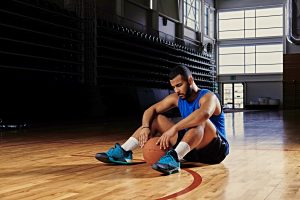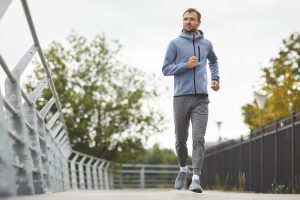Anxiety’s impact on athletic performance
Nervousness, pressure, and stress are common in sports. Some athletes prepare for this experience prior to big events. They may develop strategies that improve their focus while under pressure or may find that a boost in adrenaline enhances their performance. This approach is ideal when stress levels are moderate and within the athlete’s tolerance. But when nervousness intensifies beyond a window of tolerance to heightened levels of anxiety, athletic performance can decline.
When anxiety interferes
An anxiety disorder requires a clinical diagnosis and is different from typical feelings of nervousness. The Diagnostic and Statistical Manual of Mental Disorders, fifth edition (DSM-V), states that, “anxiety disorders differ from developmentally normative fear or anxiety by being excessive or persisting beyond developmentally appropriate periods” (American Psychiatric Association [APA], 2013, p. 189). The DSM-V identifies excessive fear as an overestimation of danger, and notes that symptoms are persistent if they generally continue for six months or more (APA, 2013).
Symptoms of an anxiety disorder can also interfere with how one typically functions. Anxiety disorders often consist of cognitive, physical, and behavioral features. Some examples include worrisome thoughts, increased heart rate, shortness of breath, and avoidance. Struggling with these types of anxiety can impact confidence and performance. Furthermore, its impact can extend to other areas of life like school, work, and relationships. Some types of anxiety disorders include generalized anxiety disorder, panic disorder, and phobias.
Performance anxiety
Performance anxiety is like stage fright, and can develop anywhere one may perform, including sports. An athlete may experience elevated stress and pressure when attempting to achieve. If athletes interpret this experience as extremely unpleasant or uncomfortable and develop a decline in performance, they may be dealing with performance anxiety. This experience alone is not considered a clinical diagnosis. However, the DSM-V identifies a performance-only specifier within social anxiety disorder / social phobia (APA, 2013). Like other anxiety disorders, the DSM-V identifies different criteria for social anxiety disorder, which is best assessed and diagnosed by a licensed clinician.
 Nevertheless, performance anxiety can occur in any aspect of one’s sport. For example, it can develop before or during practice or competition. It can also continue after these moments have passed. Athletes may become distracted, worried about being observed, or may focus on errors. As a result, this can lead to a decrease in performance and achievement.
Nevertheless, performance anxiety can occur in any aspect of one’s sport. For example, it can develop before or during practice or competition. It can also continue after these moments have passed. Athletes may become distracted, worried about being observed, or may focus on errors. As a result, this can lead to a decrease in performance and achievement.
Here are some ways that anxiety can impact athletic performance.
Anxious thoughts
Anxious thoughts can occur in a variety of ways, including worry, self-talk, or unwanted intrusive thoughts. An athlete may worry about making a mistake, feeling embarrassed or letting others down. One may worry about being in the spotlight and may become more aware of the crowd watching. Additionally, one may worry about experiencing uncomfortable physical sensations associated with anxiety when they are trying to implement a skill or being observed. Other times, athletes may compare themselves to others and begin to doubt their abilities.
Athletes may also anticipate an unfavorable situation occurring in the future. For example, an athlete may worry about getting injured. Athletes may also worry about how they will perform once they return from an injury. Or they may worry that they could get sick, feel anxious, or generally unwell when they hope to feel their best, when it is time to train or compete. Athletes may struggle with negative self-talk, limiting beliefs, or perfectionistic expectations. This inner critic may judge the slightest miss while discrediting or excluding the skills that they are executing well.
Focusing on all the things that worry the athlete can increase doubt and insecurity. Imagining everything that could go wrong makes it significantly harder to remain confident, focused, and ready to approach a task. Though anxious thoughts are unpleasant, athletes can develop skills to help them spend less time worrying about worst-case scenarios. Reframing, visualizing, and refocusing are a few ways athletes can build and develop confidence.
Anxious feelings
Common physical sensations often associated with anxiety include changes in heart rate or breathing, nausea, dizziness, shaking or trembling, and muscle tension or tightness. These feelings may make it harder to relax or remain focused. If an athlete experiences these sensations as significantly unpleasant, they can become distracted while performing. Putting more attention into the physical sensations can disrupt the athlete’s trust in their ability and technique. Finding it harder to focus, the athlete may begin to worry about freezing up.
It's important to note that anxious feelings that occur outside of training and competing can also negatively impact performance. Athletes often need adequate recovery between practice and competitions. A necessary part of recovery will include sufficient rest. Persistent anxious feelings might inhibit sleep or other relaxing activities. As a result, recovery could become more stressful than restorative. While preventing injury is important to the athlete, insufficient recovery could potentially increase their risk. Developing a strong recovery plan can help. Athletes can benefit from multiple recovery methods, including relaxation techniques, participation in other enjoyable activities, having a strong support system, and mor
Anxious actions
If worrisome thoughts and uncomfortable physical sensations feel overwhelming, they can influence the way an athlete interacts with their sport. Feelings of tension can lead to playing more timidly. The athlete may begin to play with extra caution and hold themselves back. If an athlete is worrying about freezing up, they may start second guessing. It can also lead to tardiness in practice or delays in competition.
Avoidance is another way that athletes may respond to anxiety. An athlete may begin avoiding any aspect of their sport, such as skipping practice or meetings, and sitting out during certain drills. An athlete may also avoid competing. Another way that avoidance can occur is in overtraining. By trying to eliminate feelings of anxiety, an athlete may spend too much time rehearsing and repeating. In this case, if the athlete is focused on perfectly executing a skill every time, this can put them at risk of overtraining.
 Relationship changes may also develop. The amount of time spent responding to anxiety can significantly disrupt athletic performance. An athlete may spend more time mentally reviewing, ruminating, or seeking reassurance on aspects of their training that they worry about. The more this type of worry interferes, the more doubting gets reinforced. More time worrying and doubting can reduce social connection or a feeling of belongingness. The athlete struggling with anxiety may feel alone in this experience. The athlete might also worry about how they are connecting with peers or may become more withdrawn. Recognizing these signs is an important first step. Strong communication skills can help athletes feel supported and learn how to work through these challenges.
Relationship changes may also develop. The amount of time spent responding to anxiety can significantly disrupt athletic performance. An athlete may spend more time mentally reviewing, ruminating, or seeking reassurance on aspects of their training that they worry about. The more this type of worry interferes, the more doubting gets reinforced. More time worrying and doubting can reduce social connection or a feeling of belongingness. The athlete struggling with anxiety may feel alone in this experience. The athlete might also worry about how they are connecting with peers or may become more withdrawn. Recognizing these signs is an important first step. Strong communication skills can help athletes feel supported and learn how to work through these challenges.
Participating in athletics with anxiety
Ultimately, there are several ways an athlete may experience anxiety. It is important to recognize that nervousness, pressure, and stress are common when performing a skill. Still, the levels of tolerance may vary between individuals. One athlete may feel energized by a rush of adrenaline, which may give just the right amount of competitive edge. On the other hand, an athlete may feel overwhelmed, distracted, and doubtful when tension builds up. If an athlete’s performance is more directed towards alleviating anxiety and less towards development, conditioning or achieving sport specific goals, then anxiety is likely interfering with athletic performance.
 Recognizing that pressure is increasing anxiety rather than creating a competitive edge can help athletes develop a plan to address their needs. For example, an athlete worrying about mistakes during a competition may focus on succeeding in drills during practice. Putting less emphasis on the outcome of a competition can give the athlete room to just enjoy playing the sport. This may allow the athlete to restore confidence and focus more on performance goals. Athletes dealing with self-criticism and comparison can develop positive self-talk and reframing strategies to refocus their attention on their own talents. Athletes worrying about freezing up or dealing with uncomfortable physical sensations of anxiety during competition can develop focus strategies.
Recognizing that pressure is increasing anxiety rather than creating a competitive edge can help athletes develop a plan to address their needs. For example, an athlete worrying about mistakes during a competition may focus on succeeding in drills during practice. Putting less emphasis on the outcome of a competition can give the athlete room to just enjoy playing the sport. This may allow the athlete to restore confidence and focus more on performance goals. Athletes dealing with self-criticism and comparison can develop positive self-talk and reframing strategies to refocus their attention on their own talents. Athletes worrying about freezing up or dealing with uncomfortable physical sensations of anxiety during competition can develop focus strategies.
By learning to turn the focus away from the fearful sensation or situation, an athlete can shift attention back into participating in their sport. Focus strategies can also help athletes learn to adapt quickly when unexpected circumstances arise. Similarly, visualization techniques can help athletes prepare for upcoming events.
Positive outcomes
With the right support and approach, athletes may feel better equipped to adjust under pressure, be able to maintain focus, and build their confidence. This can also help reduce overtraining or risk of burnout. Athletes may benefit from self-compassion to evoke a sense of self-trust and reliance. Effective communication and team building can also enhance trust. In other cases, athletes might work with a mental performance coach to address specific needs. Though anxious thoughts and feelings are unpleasant, athletes can develop skills to help them spend less time worrying about worst case scenarios. Just like any skill, learning how to refocus and develop confidence building strategies takes practice.
References
1. American Psychiatric Association. (2013). Anxiety disorders. In Diagnostic and statistical manual of mental disorders (5th ed.).
by Sarah Farris, LCPC



